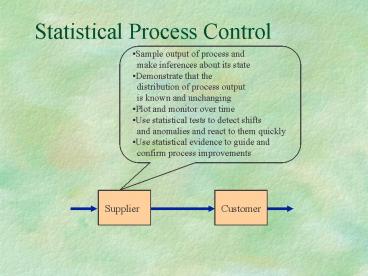Statistical Process Control - PowerPoint PPT Presentation
1 / 17
Title:
Statistical Process Control
Description:
Use statistical tests to detect shifts. and anomalies and react to them quickly ... If distribution unimodal or symmetric, then much smaller n's are acceptable to ... – PowerPoint PPT presentation
Number of Views:114
Avg rating:3.0/5.0
Title: Statistical Process Control
1
Statistical Process Control
- Sample output of process and
- make inferences about its state
- Demonstrate that the
- distribution of process output
- is known and unchanging
- Plot and monitor over time
- Use statistical tests to detect shifts
- and anomalies and react to them quickly
- Use statistical evidence to guide and
- confirm process improvements
2
Evolution from Inspection to SPC
SPC.
SPC.
SQC/SPC.
3
Statistical Process Control Topics
- Introduction to Variability
- Control Charts
- General info
- x-bar Charts, R Charts
- p Charts, C Charts
- Type 1 and Type 2 Errors
- Process Capability Analysis
4
Variation
The less variation, the better off we are.
Improve Capabilities
Common cause variation Inherent in the
system Assignable cause variation
Event-related, special (assignable special)
Analyze and Act
5
Analyze and Act React to Assignable Causes
- Note unusual variation diagnosed by using a
common test to evaluate individual data points - Identify cause by noting what change in the
process occurred at that point in time - Eliminate cause or build in the cause
- Monitor performance to verify the effect of the
fix - Generally, assignable causes cause points outside
of control limits!
6
Improve Process Capabilities Drive Out Common
Causes
- Variation is inherent in the system
- Dont react to individual points (this is
tampering) - Analyze possible factors affecting variation (use
Cause and Effect Diagram) - Work to reduce variation Make an improvement,
that is, introduce a special cause - Monitor performance to verify the effect of the
intended improvement
7
X-bar and R charts
- Sample output of process - parameter
- of interest is continuously variable
- Plot one chart to track sample means and
- another one to track sample ranges (variation)
- Use statistical evidence to detect changes
- and improve the process to better position
- the mean and to reduce variation
8
Underlying Assumptions
- process mean m and standard deviation s when the
process is in control - process may go out of control in two possible
ways - mean shifts to m1, with standard deviation
unchanged - standard deviation shifts to s1, with mean
unchanged - sample means are normally distributed (when in or
out of control, because either - process output measurements on individual units
are normally distributed when in or out of
control - OR Central Limit Theorem applies
- n gt 30 OR
- If distribution unimodal or symmetric, then much
smaller ns are acceptable to assume normality (n
on the order of 4).
9
Basic Probabilities Concerning the Distribution
of Sample Means
Std. dev. of the sample means
10
Estimation of Mean and Std. Dev. of the
Underlying Process
- use historical data taken from the process when
it was known to be in control - usually data is in the form of samples
(preferably with fixed sample size) taken at
regular intervals - process mean m estimated as the average of the
sample means (the grand mean) - process standard deviation s estimated by
- standard deviation of all individual samples
- OR mean of sample range R/d2, where
- sample range R max. in sample minus min. in
sample - and d2 value from look-up table (Appendix
Table B)
11
Example Estimation of Mean and Std. Dev. of the
Underlying Process
Estimate of the process mean m 2.3 Estimate
of the process std. dev. (1) Combined std.
dev. of all 30 points s 1.1 OR (2) s
R/d2 (n5) 2.7/2.326 1.2
12
Determination of Control Limits
- For the x-bar chart
- - Center Line grand mean
- - Control Limits usually use
- - Can analyze process capability based on the
specification limits - For the R chart
- - Center Line average range
- - Control Limits
- Use Table C (Appendix)
- Alternative Use an Economic Approach
- - Consider the cost impact of out-of-control
detection delay (Type 2 error), false alarm (Type
1 error) and sampling costs - - Difficult to estimate costs
13
Ex. Two Machines -Process Capability Analysis and
x-bar and R-charts
14
X-bar vs. R charts
- R charts monitor variability Is the variability
of the process stable over time? Do the items
come from one distribution? - X-bar charts monitor centering (once the R chart
is in control) Is the mean stable over time? - gtgt Bring the R-chart under control, then look
- at the x-bar chart
15
How to Construct a Control Chart
- 1. Take samples and measure them.
- 2. For each subgroup, calculate the sample
average and range. - 3. Set trial center line and control limits.
- 4. Plot the R chart. Remove out-of-control
points and revise control limits. - 5. Plot x-bar chart. Remove out-of-control
points and revise control limits. - 6. Implement - sample and plot points at standard
intervals. Monitor the chart.
16
Type 1 and Type 2 Error
17
Common Tests to Determine if the Process is Out
of Control
- One point outside of either control limit
- 2 out of 3 points beyond UCL - 2 sigma
- 7 successive points on same side of the central
line - of 11 successive points, at least 10 on the same
side of the central line - of 20 successive points, at least 16 on the same
side of the central line - Shows particular pattern































